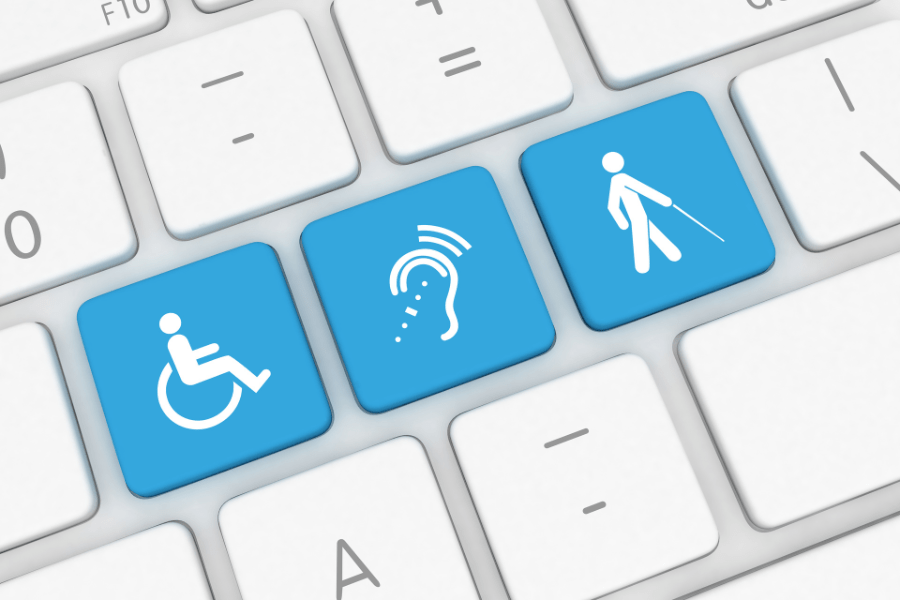
We Are All Differently Abled: What I’ve Learned About Accessibility
Natalie Lieberman Diversity, Equity, Inclusion & Accessibility, Workforce Transformation, Human Centered Design“Increasing Access and Opportunity.”
That is the theme of National Disability Employment Awareness Month as we mark the 30th anniversary of the Americans With Disabilities Act (ADA). In conjunction with this milestone, LMI has partnered with VITAC, the leading live closed-captioning provider in the U.S., for company-wide events. We have also doubled down on our commitment to diversity, equity, inclusion, and accessibility (DEIA) during this difficult time in our nation’s history.
Section 508 of the Rehabilitation Act requires government agencies to make electronic and information technology accessible to people with disabilities. Yet, numerous agencies along with many large public and private employers don’t furnish accessible content as standard operating procedure. Before we can increase access and opportunity, we need better awareness of where inequities and unequal access exist. Despite 30 years of the ADA, there is much work to do.
Despite 30 years of the ADA, there is much work to do.
Assumptions and Accessibility
I’ve come to the realization that fully sighted people inherently assume everyone is at the same vantage point. In consulting especially, we love Tableau dashboards and bleeding-edge digital content, and we’re excited for everyone to see our gorgeous visualizations. As someone with fantastic vision post LASIK and no hearing impairment, I’ve been guilty of this. It wasn’t until after I started managing remediation specialists—something I admittedly never expected to oversee during my career—that I learned more about accessibility and uncovered my own bias. I have also learned that not all impairments are visible, particularly after receiving unexpected notes of thanks for providing accessible content.
Not all impairments are visible.
As with many DEIA concerns, those of us who don’t struggle with accessibility often take for granted the ease of life’s daily tasks. I trust you’ve never seen braille next to the words “Caution: Do Not Touch” taped near a freshly painted park bench. Autoplaying media on a website may annoy you, but for users with disabilities, this content can cause seizures, compete with text-to-speech software, or even prevent site navigation or create a keyboard trap, rendering the computer unusable without intervention. When we create content with accessibility in mind, we make it better for all seeking access, no matter their stage of life or abilities.
A Human Touch to Remediation
LMI’s remediation and accessibility function has grown in tandem with federal clients’ needs to produce fully accessible content. Over the last five years, we’ve gone from remediating dozens to hundreds of documents and gotten more sophisticated with our process. Beyond my document production team, more creative colleagues assist with website compliance. These requests started with a top client under the Department of Health and Human Services, with healthcare documentation and site content available to the American public. Now, we field requests to “508” documents and websites from DoD and the military services as well as GSA and other civilian agencies. Simply put, we make content accessible to individuals using assistive technologies and automated readers.
Many software programs have added tools to test for accessibility or assist with remediation. These tools only go so far. To truly meet accessibility standards, we perform several manual checks, such as evaluating the correct reading order for tags, ensuring sufficient color contrast, and verifying the relevance of alternative text for graphics. Sure, we could check a box and achieve a lesser standard of remediation, but we know that won’t serve anyone well in the end. Even under the pressure of tight deadlines, my consultant colleagues find ways to let us do our best work. Just as you wouldn’t stop building a wheelchair ramp 80% of the way up to an entrance, you can’t declare a document or most modern websites remediated without human intervention.
How Accessibility Benefits Us All
Remember the last time you visited a website with broken links or had trouble finding content because of poor organization? The four principles of remediation—perceivable, operable, understandable, and robust—apply to everyone. Accessibility gives all people options, from being able to have a document or website read to us to more easily viewing content on a mobile device, and it increases the number of people who can access your message. Don’t think of remediation as a compliance exercise, something to tack on at the end, or a burden that ties your hands. It also doesn’t mean you can’t have eye-catching content—just that you should be more intentional about it. Through these actions, we ensure we aren’t leaving anyone behind.
Beyond our employers, it’s incumbent on us to uncover the opportunities in our own spheres of influence where we can truly make a difference. During this turbulent time, look around to see where you can knock down barriers for others. It might be where you least expect.

Diversity, Equity, Inclusion & Accessibility
We’re committed to diversity, supporting equity, inclusion, and accessibility for all. LMI's employee resource groups offer targeted opportunities for leadership, collaboration, networking, outreach, and professional development.




